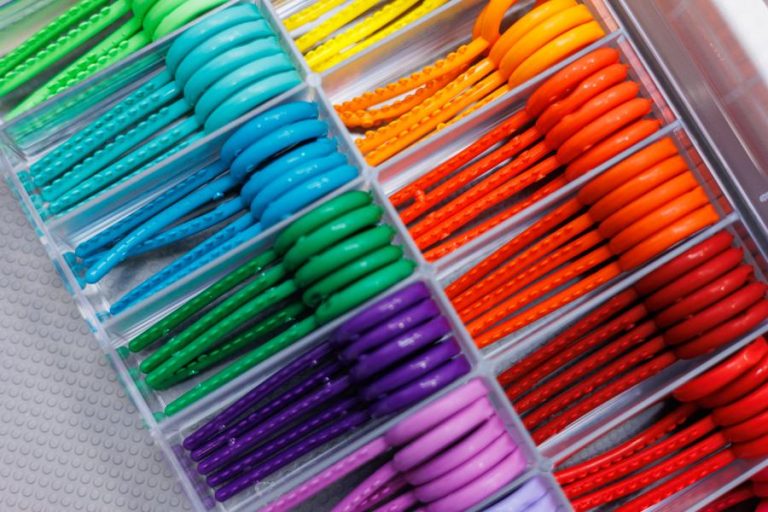436 Jacksonville Drive • Jacksonville Beach, FL 32250 190 Marketside Ave. • Ponte Vedra, FL 32081

Rubber Bands for Braces – What Are They and How Do They Work?
What Are Bands for Braces and What Do They Do?
Bands for braces can refer to two types of elastics used during orthodontic treatment. Ligatures are the small, colorful bands wrapped around each bracket to hold the archwire in place. But when most people talk about rubber bands on braces, they mean orthodontic elastics – larger rubber bands in teeth that stretch between brackets on the upper and lower jaws. So, what does rubber bands on braces do? These elastics apply targeted pressure to help correct bite issues like overbites, underbites, and crossbites. By connecting specific teeth, the bands guide your upper teeth and lower teeth into better alignment. The point of rubber bands on braces is to add a corrective force that braces alone can’t provide, helping you achieve a properly aligned bite and a straighter smile faster.How Rubber Bands on Braces Work
Orthodontic elastics may be small, but they serve a powerful function in moving teeth and jaws into the correct position. They attach to tiny hooks on brackets, forming a tension line between the upper and lower teeth. This creates a gentle pressure that helps reposition the jaw and improve how your bite fits together. Whether you need to move your lower teeth forward, adjust an overbite, or shift your upper jaw, your orthodontist will prescribe a specific configuration and strength. Common types include class II elastics, crossbite elastics, and box elastics, each used to treat different issues based on your unique case.Types and Timing of Use for Rubber Bands
Orthodontists typically introduce rubber bands several months into the treatment process, after your teeth begin to align. The type and size of bands you need will depend on your treatment progress and bite correction needs. Some elastics provide light force, while others offer stronger pressure. Since elastics lose their tension over time, you’ll need to replace them frequently—sometimes multiple times per day. That’s why many patients are encouraged to carry extra elastics and use tools like a hook tool to apply them quickly and correctly.Introduction to Rubber Bands
Rubber bands, also known as orthodontic elastics, are a vital part of many braces treatment plans. These tiny rubber bands apply extra force to the teeth and jaws, helping to correct bite problems and move teeth into better positions. Orthodontic elastics come in a variety of sizes and are usually made of medical grade latex or synthetic materials for patients with latex allergies. When combined with metal braces, ceramic braces, or clear aligners, rubber bands enhance the effectiveness of treatment. They allow orthodontists to precisely control jaw and tooth movement, making it possible to solve complex alignment issues with targeted force.Types of Braces that Use Rubber Bands
Most braces systems, including traditional metal, ceramic, and even clear aligners, can be paired with rubber elastics to provide the necessary connective force requirements for bite correction. Some advanced appliances, like lingual braces, also use elastics to improve jaw alignment discreetly. Using the right kind of elastic bands for each patient ensures a custom approach to care. With the help of elastics, your orthodontic journey becomes more efficient, leading to faster and more complete results.Benefits of Using Rubber Bands with Braces
Adding rubber bands in teeth has many benefits. They help fix bite issues, speed up the process, and guide both the teeth and jaw into proper alignment. Their ability to target specific areas with extra force makes them a powerful tool in any braces treatment plan. Wearing your elastics consistently ensures your teeth and jaws are moving according to your treatment plan, helping to shorten overall treatment time and improve oral health by aligning your bite properly.
How to Attach Rubber Bands Properly
Correct attachment of rubber bands is vital for their effectiveness. Here’s a step-by-step guide:- Identify Correct Brackets: Use the specific brackets your orthodontist pointed out.
- Pinch the Rubber Band: Hold it between your thumb and index finger.
- Gently Stretch: Avoid snapping by stretching it carefully.
- Attach: Hook one end over the designated bracket, stretch across, and hook it on the opposite jaw’s bracket.
Maintenance and Care of Rubber Bands
Proper maintenance and care of rubber bands are essential for successful orthodontic treatment. Patients should always follow their orthodontist’s instructions regarding how long to wear rubber bands each day and how often to replace them. It’s important to avoid sticky foods and hard objects that can damage the rubber bands or interfere with their function. Keeping rubber bands clean and storing them in a safe place when not in use helps maintain their elasticity and effectiveness. Regular dental check-ups and orthodontic appointments are also crucial for monitoring progress and making any necessary adjustments. By taking good care of your rubber bands, you can help ensure your treatment stays on track and delivers the best possible results.Common Mistakes to Avoid
- Attaching to the wrong brackets
- Overstretching, which weakens the bands
- Neglecting to replace snapped or worn-out bands
Types of Rubber Bands for Braces
Rubber bands vary in both strength and size to meet specific orthodontic needs. Here’s a quick guide: Strength:- Light: Minimal pressure for fine-tuning alignment.
- Medium: Moderate pressure, common for general adjustments.
- Heavy: Maximum force for major bite corrections.
- Small: For precise control over movement, often used on front teeth.
- Medium: Balanced size for most adjustments.
- Large: Wider span, ideal for complex bite adjustments.
Challenges with Rubber Bands
Adjusting to rubber bands can come with some discomfort. Many patients experience soreness at first, which is a normal part of the process. Here are a few simple ways to ease this:- Use oral pain relief as recommended by your orthodontist.
- Try over-the-counter pain relievers such as acetaminophen or ibuprofen to help manage discomfort.
- Apply dental wax over brackets or wires that may cause irritation to the inside of your mouth.
- Cold compresses can help alleviate soreness.
- Warm saltwater rinses are effective for soothing gum irritation and can also help calm the gums.
Consistency is Key: Tips to Remember
- Keep Extras Handy: Store extra rubber bands in places like your bag, bathroom, or nightstand.
- Set Reminders: Use phone alarms, sticky notes, or reminders associated with daily habits (like brushing) to stay on track with replacements.
- Follow Instructions: Inconsistent use can delay treatment, cause discomfort, and even reverse progress.

How Long Do You Need to Wear Rubber Bands?
Duration varies based on individual needs. Most patients use rubber bands for several months, but in complex cases, it could take over a year. Consistent wear is essential for achieving desired outcomes within your expected timeframe.
After rubber bands and braces are removed, a retainer is often prescribed to help maintain the new position of your teeth. Retainers are important because they prevent your teeth from shifting back to their previous position after treatment.
Estimated Duration:
- Minor Bite Correction: 3–6 months
- Moderate Alignment Issues: 6–12 months
- Significant Bite Correction: 12+ months
What Happens if You Skip Wearing Rubber Bands?
Skipping days or not wearing them consistently can set back your progress, prolong your treatment, and even lead to extra adjustments. Inconsistent use of rubber bands can also negatively affect how your teeth fit together, making it harder to achieve proper alignment. For the best results, wear your rubber bands as instructed.
Braces Cost and Rubber Bands
The cost of braces can vary widely depending on the type of braces you choose, the complexity of your orthodontic treatment, and your orthodontist’s location. Traditional metal braces typically range from $3,000 to $7,000, while ceramic braces and self-ligating braces can cost between $4,000 and $10,000. Clear aligners usually fall within the $3,000 to $8,000 range.
Rubber bands and elastic bands are typically included in the overall cost of treatment; however, some orthodontists may charge extra for replacements or additional supplies. If you have multiple family members undergoing treatment, ask about discounts or payment plans that can make braces more affordable. Many orthodontists offer flexible financing options to help you manage the cost of treatment and achieve a healthy, beautiful smile without financial stress.
Can You Eat with Rubber Bands On?
It’s recommended to remove rubber bands during meals for easier cleaning and to prevent food from getting stuck. Always replace them with fresh bands after eating. Brushing with fluoride toothpaste after meals helps prevent cavities and supports oral health during orthodontic treatment. Be sure to monitor for dental conditions such as cavities or gum issues while wearing braces.
Final Takeaway
Rubber bands are a small yet powerful part of your orthodontic journey, helping to guide your teeth into perfect alignment. Rubber bands and braces work together to improve jaw alignment and address jaw issues, which are essential for both function and appearance. They are also used to correct problems such as misaligned teeth and bite issues, ensuring better dental health.
For younger patients, monitoring jaw growth is a crucial part of orthodontic care, enabling the identification and early addressing of potential concerns. By wearing them consistently, replacing them as needed, and following your orthodontist’s guidance, you’re on track to achieve that dream smile faster.
For more information, please call (904) 270-8750 or complete a contact form.
FAQs about Rubber Bands for Braces
What are bands for braces used for?
Bands for braces, also known as orthodontic elastics or rubber bands, are used to help align the bite by connecting the upper and lower teeth. Unlike the small ligatures that hold the archwire in place, these bands apply extra pressure to move the jaw or specific teeth into proper position. They are essential in correcting overbites, underbites, crossbites, and other bite issues during orthodontic treatment.
What does rubber bands on braces do?
Rubber bands on braces apply gentle but continuous pressure that helps shift your teeth and jaw into alignment. They’re often attached from a bracket on the upper teeth to a bracket on the lower teeth, guiding bite correction. Orthodontists prescribe them for patients who need additional force beyond what the braces alone provide. Consistent wear speeds up the alignment process and contributes to a straighter, more functional smile.
What is the point of rubber bands on braces?
The main purpose of rubber bands in braces is to fix how your upper and lower jaws meet. While braces move the teeth into better positions, rubber bands address the relationship between your bite and jaw alignment. They’re often used to move the lower jaw forward or adjust vertical or diagonal bite discrepancies. Without them, braces might not be able to complete the full correction needed.
How long do you wear rubber bands for braces?
The length of time you’ll need to wear rubber bands depends on your individual treatment plan. Most patients wear them for several months, but some may require them for a year or more. Typically, rubber bands are worn 20–22 hours per day and replaced multiple times a day to maintain consistent pressure. Your orthodontist will let you know exactly how long you need to wear them based on your case.
Do rubber bands on braces hurt?
Rubber bands may cause mild discomfort or soreness when you first start wearing them, as they begin to apply pressure to your teeth and jaw. This sensation usually fades within a few days as your mouth adjusts. If pain persists or becomes severe, your orthodontist may recommend switching to a different size or strength of band. Over-the-counter pain relief and warm saltwater rinses can help ease temporary soreness.
The information provided in this blog is for educational and informational purposes only. It is not intended as a substitute for professional medical, dental, or healthcare advice. Always consult with a qualified healthcare provider for diagnosis, treatment, and answers to specific medical questions.




